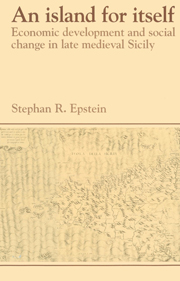Book contents
- Frontmatter
- Contents
- List of maps
- List of tables
- Acknowledgments
- Abbreviations
- Currency and measurements
- Chronology
- 1 Introduction. The historiography and the sources
- 2 Regional geographic and demographic differentiation
- 3 Market structures and regional specialization
- 4 Sicily and its regions. Economic growth and specialization
- 5 Sicily and its regions. Eastern val Demone and the southern mainland
- 6 Foreign trade and the domestic economy
- 7 Income distribution, social conflict and the Sicilian state
- 8 A further question: the origins of Sicilian underdevelopment
- Bibliography
- Index
- Past and Present Publications
1 - Introduction. The historiography and the sources
Published online by Cambridge University Press: 06 January 2010
- Frontmatter
- Contents
- List of maps
- List of tables
- Acknowledgments
- Abbreviations
- Currency and measurements
- Chronology
- 1 Introduction. The historiography and the sources
- 2 Regional geographic and demographic differentiation
- 3 Market structures and regional specialization
- 4 Sicily and its regions. Economic growth and specialization
- 5 Sicily and its regions. Eastern val Demone and the southern mainland
- 6 Foreign trade and the domestic economy
- 7 Income distribution, social conflict and the Sicilian state
- 8 A further question: the origins of Sicilian underdevelopment
- Bibliography
- Index
- Past and Present Publications
Summary
A problem that has haunted the Italian nation since its inception is that of the origins and causes of the current economic and social disparities between North and South. For a long time it has been assumed that the answer to the problem – known as the questione meridionale, the southern question – could be found in the Middle Ages. There is, indeed, a general consensus that the economy of southern Italy or Mezzogiorno (which includes Sicily and Sardinia and borders on central Tuscany to the north) was permanently overtaken by that of central and northern Italy at some point during the high or late Middle Ages.
In this book I suggest a very different interpretation. Taking late medieval Sicily as my example, I argue that the region showed considerable economic, demographic and social dynamism, and that it provides an important test-case for a more general theory of economic development in late medieval Europe as a whole. Contrary to prevailing views that the period was one of economic stagnation or contraction, I suggest that the main result of the late medieval social and economic crisis was to increase regional specialization and integration, which in turn provided the base for the demographic and economic upsurge of the late fifteenth century. However, opportunities for specialization were not pursued in identical fashion throughout late medieval Europe. Each regional ‘path to development’ was shaped by that region's specific constellation of social institutions defining access to markets and trade.
- Type
- Chapter
- Information
- An Island for ItselfEconomic Development and Social Change in Late Medieval Sicily, pp. 1 - 24Publisher: Cambridge University PressPrint publication year: 1992



